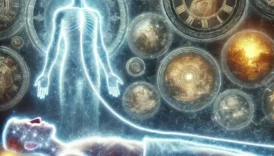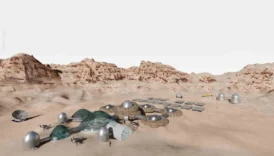SCIENTIFIC RESEARCH IN PARAPSYCHOLOGY
Parapsychology is often perceived as a mysterious and controversial field of study that focuses on exploring the limits of the human mind’s perception and influence. Telepathy, telekinesis, and clairvoyance—phenomena sometimes labeled as “extraordinary” abilities—have captured humanity’s attention for centuries. Modern research has sought to test these abilities under controlled experimental conditions. In this context, experiments conducted in university laboratories and subsequent statistical data lie at the heart of efforts to place parapsychology on a more scientific foundation. In this article, we will comprehensively examine the history of parapsychology, current experiments at universities, statistical findings, and the importance of academic research in this field.
- SCIENTIFIC RESEARCH IN PARAPSYCHOLOGY
- 1. Historical Development of Parapsychology
- 1.1 Early Research Efforts
- 1.2 Rhine and Laboratory Experiments
- 2. Experiments at Universities
- 2.1 Ganzfeld Experiments
- 2.2 Psychokinesis (Mind-Over-Matter) Studies
- 2.3 Remote Viewing Investigations
- 3. Statistical Approaches and Data Analysis
- 3.1 Meta-Analysis Techniques
- 3.2 Effect Size Measurements
- 3.3 Negative Findings and Publication Bias
- 4. Critiques and Debates
- 5. Current Developments and Future Directions
- 5.1 Neuroscience and Brain Imaging Technologies
- 5.2 Quantum Theory Explanations
- 5.3 Interdisciplinary Collaboration
- 6. Conclusion
- References
1. Historical Development of Parapsychology
1.1 Early Research Efforts
Serious early attempts at studying parapsychological phenomena can be traced back to the late 19th century. Phenomena such as spiritual investigations (psychical research) and mediumship intrigued the intellectual community of that period. The formation of organizations such as the Society for Psychical Research launched systematic surveys and field investigations under a scientific framework. However, laboratory-based experimentation did not become widespread until the 20th century.
1.2 Rhine and Laboratory Experiments
In the early 20th century, J. B. Rhine and his team at Duke University conducted card-guessing experiments (using Zener cards) to investigate telepathy and clairvoyance. Rhine’s research is considered one of the earliest major efforts to establish parapsychology as an experimental science. He analyzed his results using statistical methods and reported unexpectedly high hit rates.
2. Experiments at Universities
2.1 Ganzfeld Experiments
Ganzfeld experiments are designed to test mind-to-mind information transfer by partially isolating participants from external sensory input. These experiments, carried out at institutions like the University of Edinburgh and the University of Amsterdam, stand among the most frequently replicated in the field of parapsychology. In these studies, one participant (the “sender”) concentrates on a specific image or video, while another participant (the “receiver”), placed in an isolated environment, attempts to perceive it.
- Statistical Results: Meta-analyses involving numerous repeated trials report that correct guessing rates often range between 33% and 35%. This is statistically above the chance level of 25% (Rhine, 1937), although critics point to potential methodological flaws in some studies.
2.2 Psychokinesis (Mind-Over-Matter) Studies
The Princeton Engineering Anomalies Research (PEAR) project at Princeton University tested whether the human mind could influence random event generators. Participants were instructed to “push” the devices’ output distributions in a certain direction—either higher or lower—through focused intention.
- Statistical Findings: Across nearly 12 million trials, small but consistent deviations from random chance were recorded (Jahn & Dunne, 1987). These effect sizes were small, and replication efforts in other settings have produced mixed results.
2.3 Remote Viewing Investigations
Remote viewing experiments require participants to describe or depict a location or object that is hidden or unknown to them. Various programs, including those at the Stanford Research Institute (SRI), have tested participants who attempt to visualize distant targets.
- Experimental Setup: The participant provides sketches or verbal descriptions of the unknown target, which are then evaluated by independent judges who do not know the actual target. They rate how closely the descriptions match the real target.
- Statistical Analysis: Some studies have claimed accuracy above random expectations (Targ & Puthoff, 1977). However, critics highlight that strict controls might not have always been maintained.
3. Statistical Approaches and Data Analysis
3.1 Meta-Analysis Techniques
Meta-analysis is one of the most commonly used methods in parapsychological research. By combining results from multiple studies conducted across different locations and times, researchers can derive more statistically meaningful conclusions. While these meta-analyses often indicate small to medium effect sizes, they also reveal some consistency under certain experimental conditions.
3.2 Effect Size Measurements
Parapsychological experiments typically exhibit low effect sizes, necessitating large sample populations to detect any meaningful signals. Researchers accumulate data over extended periods and multiple replications to determine the robustness of the observed effects. In many studies, effect sizes range between 0.1 and 0.3—statistically significant but modest in magnitude.
3.3 Negative Findings and Publication Bias
A critical issue in parapsychological research is publication bias. Studies that fail to find significant effects often go unpublished, leading to a skewed impression of positive outcomes in the literature.
4. Critiques and Debates
- Methodological Limitations: Detractors point out that experimental designs may not always guarantee complete blinding, potentially allowing unintentional information leakage.
- Replicability Issues: Replication is a core principle of scientific inquiry; however, many parapsychological results are not consistently reproduced in different labs.
- Nature of Findings: The small effect sizes and primarily correlational nature of many studies hinder broad acceptance of parapsychology within mainstream science.
5. Current Developments and Future Directions
5.1 Neuroscience and Brain Imaging Technologies
Advances in brain imaging technologies offer promising opportunities to explore parapsychological phenomena. Using tools like fMRI and EEG, researchers can observe the brain activity of individuals who claim to experience telepathy or clairvoyance, potentially providing insights into the neurological underpinnings of these phenomena.
5.2 Quantum Theory Explanations
Some scientists propose that principles of quantum mechanics—such as entanglement and superposition—may underlie parapsychological effects. Although there is no definitive scientific consensus, investigating the potential link between parapsychology and quantum physics remains an intriguing area.
5.3 Interdisciplinary Collaboration
Psychologists, anthropologists, neuroscientists, and physicists have begun collaborating more extensively on parapsychology research. These collective efforts foster more rigorous, diverse experimental designs. Additionally, the emergence of big data analytics and AI-driven statistical techniques could help address the replicability issues that currently challenge the field.
6. Conclusion
Parapsychology remains a field where the traditional scientific method is challenging to apply. Nevertheless, university-based experiments and statistical data have provided a more objective grounding than in earlier years. Research into telepathy, telekinesis, and clairvoyance under controlled laboratory conditions has yielded a body of knowledge and methodological insights. Yet, problems like replicability, methodological constraints, and publication bias continue to limit the broader acceptance of parapsychology within the scientific community. Looking ahead, interdisciplinary research and evolving technologies may pave the way for a deeper understanding of these elusive phenomena.
References
- Rhine, J. B. (1937). New Frontiers of the Mind. Farrar & Rinehart.
- Jahn, R. G., & Dunne, B. J. (1987). Margins of Reality: The Role of Consciousness in the Physical World. Harcourt Brace Jovanovich.
- Targ, R., & Puthoff, H. (1977). Mind-Reach: Scientists Look at Psychic Ability. Delacorte Press.
- Society for Psychical Research (1892). Proceedings of the Society for Psychical Research. SPR Publications.
- Broughton, R. S. (1991). Parapsychology: The Controversial Science. Ballantine Books.
- Carter, C. (2012). Science and Psychic Phenomena: The Fall of the House of Skeptics. Inner Traditions.





